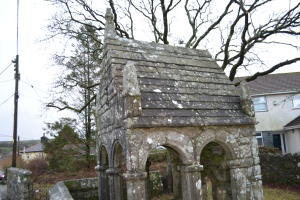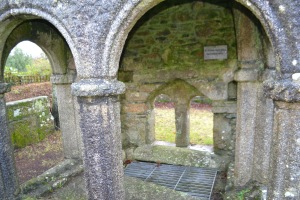St Cleer’s Well, Cornwall – a cure for insanity?
 Recently I had the opportunity to visit one of Cornwall’s most impressive holy wells, St Cleers well on the edge of Bodmin Moor at St Cleers. A Lane-Davies in this 1970 Holy wells of Cornwall is very clear that this is:
Recently I had the opportunity to visit one of Cornwall’s most impressive holy wells, St Cleers well on the edge of Bodmin Moor at St Cleers. A Lane-Davies in this 1970 Holy wells of Cornwall is very clear that this is:
“Not St Cleer’s well but the holy well in the parish of St Cleer.”
This is one of Cornwall’s most impressive wells and indeed has a fairly unique structure, having open arches on all sides and in all intents and purposes resembles a shrine and perhaps may have held relics – although this would indeed make it unique. It is more probable that it would enable more people to access the waters
William Hals in his 1700 Parochial history of Cornwall is the first to record the site:
‘In this parish is yet to be seen a famous chapel Well, dedicated to S. Clare, a work of great skill, labour, and cost, though now much decayed . . .’
Lane Davies states:
“During the Reformation and later days of political strife these structures were neglected and fell into ruin…the road encroached on the site and the first cistern filled in.”
He continues:
“illustration..of an ancient print…shews the utter ruin of the building of the site. In 1855 Lt Henry Rogers RN purchased from a local miner the ‘waste spot and ruins called St Cleer’s Well, comprising of the ancient well chapel and 61/2 perches of land. Water still flowed from the well out into the ruined bowssening pool, a muddy irregular pond villagers brought their animals to.”
Indeed it had certainly became ruinous around this and became the focus of a number of romantic illustrations. Quiler-couch notes:
“ When I visited this interesting well in 1850, and made the sketches of it here appended, it was a very pretty group of ruins. The cross, of Latin form, about seven feet high and recededed on both sides, stood near the well, the front of which, partly enveloped in ivy, was fairly entire. The arches and buttresses, well moulded, showed it to have been once a work of great skill, labour and cost. The entrance was by a double arch, the central mullion being imperfect. The back of the well was down, and the space partly filled with the sharply-cut and well-fashioned ruins.”
Addition he notes:
“In 1864 it was restored by the family of Rogers of Penrose, near Helstone, to the memory of the Rev. John Jope, for sixty- seven years vicar of the parish, as is recorded on a slab in the wall.”
Restoration was done by Liskeard based architect Henry Rice, ensuring that its restoration was in keeping with its original medieval that the improvements over 150 years later look indistinguishable.
Who was St Cleer?
Charles Hope in his 1893 in the Legendary Lore of Holy Wells tells us via Hals that they were:
“born of honourable lineage at the city of Assisum in Italy, in the province of Umbra; and being from her youth a practiser of the Christian religion with great zeal, she became desirous to follow a religious course of life ; and to that end applied herself to St. Francis, who lived in that city, and made known the same to him ; who greatly commended her for it, and soon after consecrated her a nun by cutting off her hair, and apparelling her in the habit of the order of the Nuns of St. Benedict. He carried her to the monastery of St. Paul in that city, which was of that order, where she remained till St. Francis had repaired the church of St. Damian, without the city, in a solitary place, wherein he set her ; in which she was closed up in the love of Jesus Christ, and there begun or set up a college of virgins called the Order of the Poor Clares of St. Benedict , under the solemn vows of obedience, poverty, and chastity, according to the rule of St. Francis/’ St. Cleer’s Well is said to have belonged to a nunnery, once extant either in this parish or at Liskeard, of one of the three Orders of Poor Clares.”
Traditions of the well
Quiller-Couch notes that:
“The water is good and plentiful. I tried to gather something of the legends connected with the well, but was only told tantalisingly that there were many strange stories about it, that it was still held to have miraculous virtues, and was resorted to by the halt and the blind. I could get no confirmation of the statement that it was once a bowsening pool”
A bowsening pool being a pool used to treat madness of which there are other examples in Cornwall. One wonders if the placement of a stone over the main part of the pool was intentional to prevent this. Of this there appears to be no other tradition other that there is the stones were cursed:
“Many of our Cornish wells have, as in the case of St. Nun’s in Pelynt, 1 some tradition connected with them, intended by those who first gave them currency to stay the hand of the destroyer. This has been so saved that it would not be difficult to effect an entire restoration from the ruins which lie scattered round. I learnt from a native of the parish that some of the stones of the well have been at various times carted away to serve meaner purposes ; but they have, by some mysterious agency, been brought back again during the night. This account describes St. Cleer Well as it was in the year 1850.”
Currently, the site has become a small rag well with ribbons and other offerings being made. More recently a new tradition appears to be emerging, when the Cornwall Heritage site acquired it they revived or introduced well dressing. Their website records :
“Cornwall Heritage Trust celebrates new historic site by reviving well dressing in St Cleer
We celebrated the acquisition of our 13th historic site, St Cleer’s Well, last Friday by reviving the annual tradition of dressing the monument.
In spite of the rain, the event had a truly joyous atmosphere. The artwork created by the children from St Cleer Primary School for the event was wonderful, as was the vibrant array of posies they laid at the well as part of the ceremony. After the blessing, readings in Cornish and English and a rousing (if a little damp) rendition of Trelawney, the morning was rounded off with Cornish dancing back at the school – the perfect, raucous end to the festivities!”
Hopefully this will be an ongoing tradition at this evocative well,.
Posted on October 18, 2023, in Cornwall. Bookmark the permalink. Leave a comment.





Leave a comment
Comments 0